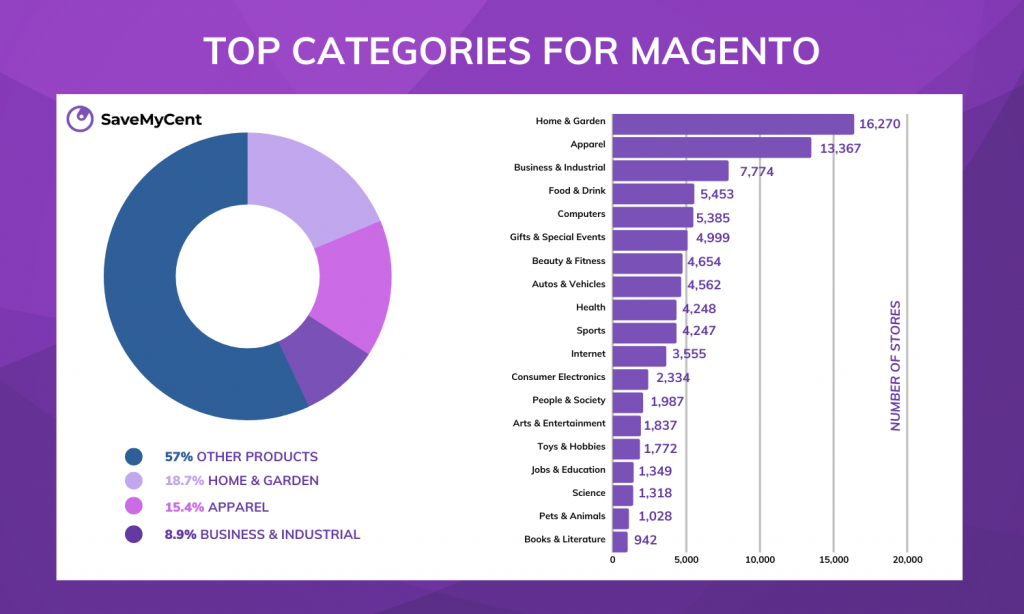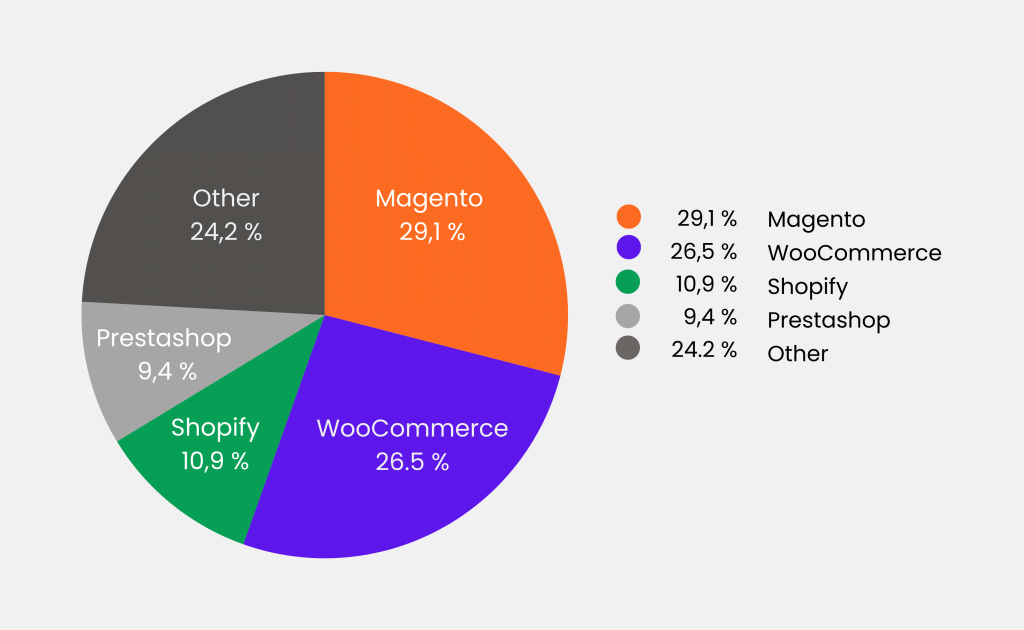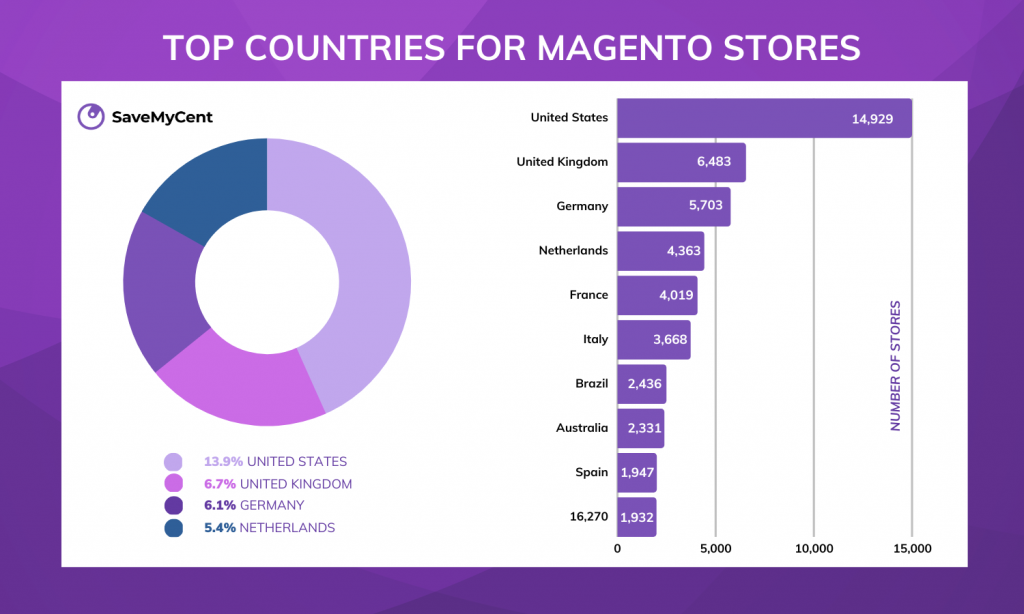
In the ever-evolving world of Commerce, one platform stands out as a titan of flexibility and power: the Magento platform. But beyond its robust reputation, Magento harbors a treasure trove of hidden gems and surprising Magento statistics that can elevate your online store to new heights. Buckle up, because we’re about to embark on a captivating journey through 20+ intriguing aspects of Magento that will leave you spellbound and ready to unlock its full potential.
1. 2018 witnessed a $1.6 billion payment from Adobe to acquire Magento.
Adobe already had a strong digital marketing and content management presence with solutions like Adobe Experience Cloud. Therefore, acquiring Magento allowed them to enter the fast-growing e-commerce platform market and become a one-stop shop for businesses building online stores. In addition, the Magento platform could be integrated with Adobe’s marketing and analytics tools, creating a more comprehensive e-commerce solution for customers. Magento statistics reveal a platform in hyperdrive, a testament to the power of this strategic union.

2. Magento is growing rapidly, with almost 710,778 websites spread globally. Today, almost 144,035 websites are live on this platform.
Magento supports 0.13% of all sites on the internet. Three industrial verticals account for more than 25% of all websites created using Magento. According to Magento statistics as of 2023, 18.7% of merchants on the platform were associated with domains that sold goods for the home and garden. The other two leading categories with the highest percentage of Magento usage are business and industrial products (8.9%) and apparel (15.4%).

Interestingly, not all websites built on the Magento platform go live immediately. Some sites may be under development, undergoing testing, or simply waiting for launch. The 710,778 figure could include websites in various stages of the development process, including those not yet ready for public access. Some live websites might become inactive over time. Businesses may shut down, change platforms, or simply neglect their online presence.
3. Magento-based platforms facilitated the sale of $155 billion worth of merchandise in 2019 and over $224 billion in revenue in 2020.
In 2019, a whopping $155 billion waltzed through Magento’s e-commerce doors, attributed to 10 to 80% of revenue growth by e-commerce businesses. From household names like Coca-Cola, Ford, and Nike to innovative startups, Magento empowers businesses of all sizes to connect with customers and drive sales. Therefore, whether they are a seasoned retailer or a budding entrepreneur, Magento can be the key to unlocking your e-commerce success.
4. As of March 2016, Magento holds a 29.1% market share in global e-commerce platforms, higher than Shopify in 2020.
Magento statistics reveal that it continues to maintain its dominant position in the market, capturing a substantial 29.1% of the market share. In 2022, WooCommerce reigned supreme with 25.2% market share, catering to smaller businesses. Shopify trailed at 19.7%, luring diverse clients with its user-friendly interface. Squarespace held steady at 14.67%, ideal for design-focused brands. Magento platform drastically dipped to 8.7%, its complex features limiting wider appeal despite its influence on larger players.

5. Most Magento users are in the United States; UK is the second-most populous nation with 10,794 active Magento websites.
Both the US and UK have established and robust e-commerce markets. They were among the first adopters of e-commerce platforms, including Magento, which gave them a head start.
Moreover, the larger population and higher overall online penetration in these countries naturally translates to more potential Magento users.

6. More than 6,000 developers achieved Magento certification.
The Magento platform is one of the most widely adopted platforms out there, which means it’s also home to many certified developers. Over 6,000 individuals have climbed the Magento ladder, earning coveted certifications like Adobe Certified Commerce Developer, Adobe Certified Commerce Business Practitioner, and Adobe Certified Expert – Magento Commerce Developer,… This means that merchant can ensure that their store complies with all the latest security and performance standards set by Magento when outsourcing their project to professional firms.
7. Magento’s original target was developing software.
After that in 2018, Adobe acquired Varien, Inc., resulting in a transfer of ownership of the latter to the former. This acquisition gives Magento the advantage of accessing Adobe’s extensive resources and expertise, thereby providing new possibilities for expanding and evolving its platform. Magento’s foray into website development was driven by the objective of broadening its market presence. Notably, Adobe’s substantial worldwide customer network serves as a valuable asset for Magento, facilitating outreach to a larger number of enterprises and augmenting its market penetration. Furthermore, the decision to transition to Adobe represents a strategic maneuver to fortify Magento’s marketing capabilities, ultimately fostering its growth and attaining success. Magento statistics above highlight the platform’s reach, and this infusion further fuels its expansion.
8. The primary language used to develop Magento websites is PHP, with nearly 60% of all code written in this language.
PHP, HTML, CSS, and SQL are essential components in the fundamental structure of web pages. While HTML and CSS (40%) pair up for structure and visual artistry, JavaScript (5%) brings dynamic elements to life, and SQL (3%) meticulously manages data. PHP conducts this orchestra from the server side, while specialists like Python and Java add their unique voices. Together, these languages create a robust web development ecosystem with diverse functionalities and seamless integration.
9. Ukraine produced 99.9% of the code for Magento.
While Ukraine played a major role, contributions from other countries shouldn’t be overlooked. Developers from the US, Europe, and other regions also contributed to Magento’s development.
Magento is an open-source platform, meaning anyone can contribute code and features. This global community of developers further diversifies the source of contributions. After Adobe acquired the Magento platform in 2018, its engineering teams joined the development process, adding another layer of diversity.
10. Magento is downloaded almost 5,000 times daily.
It is estimated that there are 1.8 million downloads on Magento statistics every year. The daily download rate of Magento amounts to nearly 5,000 instances, indicating a considerable level of adoption and interest in the platform within the developer and e-commerce communities. This robust download activity signifies the recognition of Magento’s capabilities and its appeal as a framework for creating online stores and conducting business transactions.

11. More than 3,500 Magento extensions are available on the Magento platform.
The Magento platform offers a wide selection of over 3,500 extensions that users can add to their online stores. Some of the popular extensions include Mageworx SEO Suite, which provides powerful tools for improving search engine optimization and has received positive reviews from users. Another popular extension is Amasty Improved Layered Navigation, which enhances the filtering and navigation of products on the website, making it easier for customers to find what they’re looking for. Additionally, Mageplaza Google Tag Manager is a handy extension that seamlessly integrates Google Tag Manager into the Magento platform, making it simpler to track and collect data for analytics purposes. These extensions offer valuable functionalities that enhance the overall performance and user experience of Magento-powered online stores.
12. An annual transaction value of USD 155 billion is processed by Magento.
Regarding transaction handling, Magento occupies the second position, while Shopify has achieved a significant milestone with approximately 240 billion in transactions. Big Commerce follows suit with a total of 100 billion, whereas Woo has impressively processed transactions amounting to 365 billion.
13. Magento’s vast ecosystem includes 1,300+ accredited partners.
Magento has built a vast network of more than 1,300 Magento 2 partners, allowing it to continue serving the world with its inventive and potent application. These partners consequently keep offering services to all users. This could entail creating the site’s design, putting a business solution into action, improving the functioning of the store, and offering continuing maintenance.
14. The page loading time of Magento 1 is 50% faster than Magento 2.
While Magento statistics may paint a picture of impressive adoption and reach, one area has sparked a debate: page loading times in Magento 2. The increased page loading times of Magento 2 can be attributed to several factors, including advancements in technology, reduced cost complexity, improved caching mechanisms, and optimized database structure. These elements collectively contribute to a more comprehensive understanding of the reasons behind the extended loading times experienced with Magento 2.
Magento provides extensive customization capabilities, empowering businesses to meticulously craft online stores that perfectly reflect their brand identity and address specific operational requirements. This robust platform seamlessly handles high-traffic volumes and complex product catalogs, rendering it particularly suitable for large enterprises. Furthermore, Magento boasts a vibrant and active open-source community, offering invaluable support, a plethora of extensions, and readily available development resources.
14. Magento CE has 24.8% of the e-commerce market share while Shopify has 9% in 2021.
While Magento statistics might showcase its impressive reach and adoption, the true story lies in the platform’s hidden that have the potential to enhance your e-commerce platform’s endeavors significantly. At Wgentech, a Bronze Solution Partner for Magento Commerce, we’re passionate about unlocking this potential for businesses like yours. Please don’t hesitate to schedule a free consultation with our specialist if you have any questions about Magento 2!








